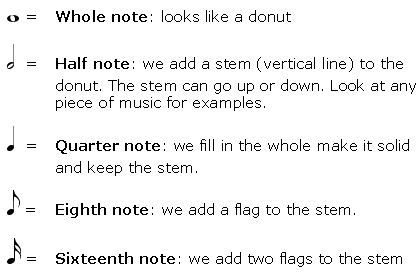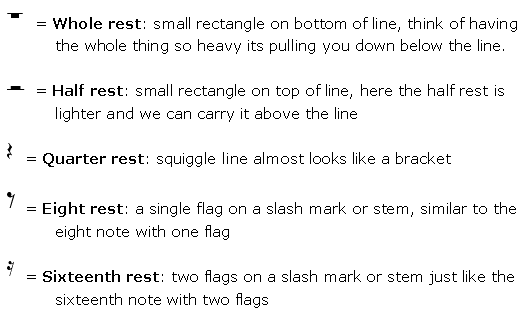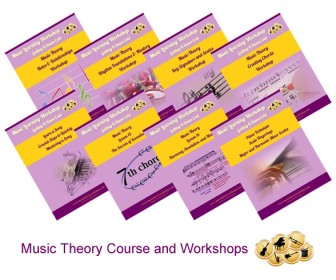Learn to Recognize and Use the Symbols of Music Notes
Symbols:
 The music note symbols are similar in shape and easy to recognize. We need to start with some basic symbols to be able to work with rhythm. We start with only showing symbols for music notes here. We will further define relationships in Music Math Theory.
The music note symbols are similar in shape and easy to recognize. We need to start with some basic symbols to be able to work with rhythm. We start with only showing symbols for music notes here. We will further define relationships in Music Math Theory.
If you are familiar with notes, rests, beams, and ties you can skip to the next section. But review the symbols so you know what they are.
The Note:
In music we choose the note as one of the ways to show how our music will be played. So let’s look at defining notes for the music theory. The note will represent when an instrument will be played. Be it a drum, keyboard, brass, guitar, our legs, a table top, or what ever.
Our basic set consists of the Whole note, the Half note, the Quarter note, the Eighth note, and the Sixteenth note. What does all this mean?
Simply take a whole dollar and divide it by two, (half dollar) and then again by two, (quarter) and by two again (bit=eighth) and two again (half bit= sixteenth). Look below and you can see the how we express the notes.
Notes:

These are the five basic note symbols we use in most of the music and rhythms we will play.
Dotted Notes:
We need to add one more component to complete our basic rhythm symbols. That will be the dot “.”, Here’s how it’s applied. Add it directly behind the note and it becomes a dotted note. It means add half the value to the note. We will look at that in music math.

We can add the dot to the other notes as well, this means to add half as much to the value again.
Rests:
Our next symbol concept is the “rest”. The rest will represent when an instrument or beat is not played.
So we will not strike a beat or beats when a rest appears. You get to relax and allow silence to be part of your rhythm. Silence is just as important as sound. It allows you add space and accents to your music. Keep this in mind when you listen to your music choices and see if you can find the rest points.
The rests:

These are the five basic rest symbols we use. So each note has an equal rest.
Dotted Notes:
And for our dotted notes we have dotted rests. They are applied as with notes.

Beams:
Before we move on let’s explore the beaming of notes. Connecting together the flags of eighth and sixteenth notes is called a beam. It simply means pairing up the notes so there isn’t a big long stream of individual notes. They would be hard to read, but instead, by grouping the notes they are much easier to read.
Compare the following:
8 eighth notes

8 sixteenth notes
![]()
Grouping provides a great way to easily read and recognize our rhythm pattern for these notes.
Different note heads
When rhythm is shown, there are other ways to show the notes. The note circles, our donut and filled donuts are called heads of the notes. Because they can be time consuming to draw we can use other ways to show them.
The x head and the slash heads are very popular for showing straight rhythm and not be concerned with what note might be played.
x-head examples: ![]()
often in fake books we see slashes, for 4 beats 
Ties:
Another symbol we need to explore is the tie. Look at this sweeping line that connects the two notes. This is the tie. It purpose in rhythm is to connect the notes to make them one note.
Our first set of notes show a quarter note and an eighth tied together giving them the same count value as a dotted quarter note.

Our second set shows how a dotted quarter note is tied across a bar line with an eighth note and a quarter note. We won’t be able to show a dotted quarter note across a bar line so this is a one way we can use a tie.
Ties are used to help combine notes of the same sound to show a longer duration and make it easier to read and see in time.
Here’s how we might see it written on a staff line:

At this point we are only trying to see what a tie looks like and how it is used. We’ll get into what this means in rhythm later on. So for now just understand that the tie will let us show two or more notes put together to be able to show a longer length of time and be able to more easily read our music and rhythm.
That’s a lot of music note symbols to absorb. Fill in Music Note Symbol Practice to understand all the notes, rests, beams, and ties. That will set you on your way to mastering music note symbols.
Learning Resources

